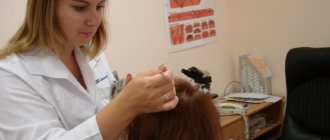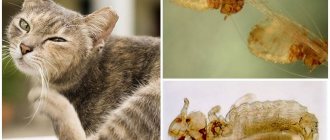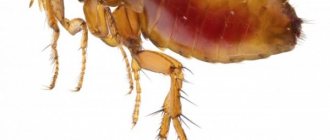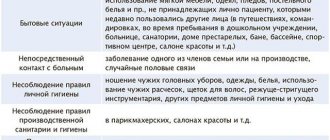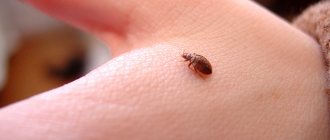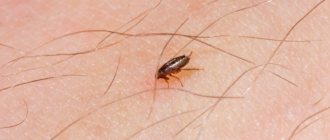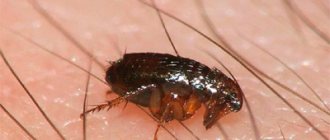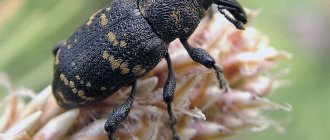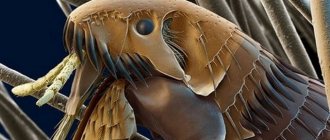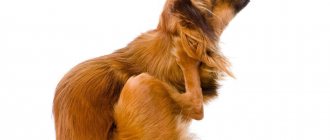Signs of pubic lice
The main symptom of phthiriasis (pubic lice infestation) is itching. It may get worse at night. Because of it, scratches and ulcers form on the skin. It is not always possible to see the insects themselves - they are small in size (no more than 2 mm, and usually much smaller). Lice attach to the hair and appear as dark specks at the base of the hair. When infected with lice pubis, black dots and grains may appear on the underwear. Parasites can live not only in the genital area, but also on the skin in the armpits and other areas of the skin covered with coarse hair (including eyelashes and eyebrows). Pubic lice never live on the scalp, since their limbs are adapted to hold only a triangular cross-section on the hair, while the hair on the head has a round cross-section.
Where else can lice live?
The human louse parasitizes humans. There are three types of insects known to cause head lice:
- 1. The head louse is named after its habitat, which is the hair of the human body. The head, mustache, and beard are the places where head lice live. Females of this species of parasites lay 4-8 eggs per day, over the entire life cycle - about 140 eggs. After one mating, the female lays eggs daily for 1-1.5 weeks.
- 2. Body louse – linen or bed louse. This subspecies parasitizes the human body, feeds on his blood, accumulating in the folds of bed linen. A body louse can lay 6-14 eggs per day, and about 300 eggs over the entire life cycle. Linen lice are common in all places where people live.
- 3. There is another type of lice that affects humans: the pubic louse, or flat louse. The main habitats of the parasite are the pubis, the scalp of the genitals and the anus. Ploschita can also settle in the armpits, chest, abdomen, eyebrows and eyelashes. Infection occurs as a result of direct contact with insects, and much less often through underwear.
If you know where lice live, you can promptly detect the appearance of parasites on your body and get rid of them. The most serious epidemiological danger is body lice.
How do you get pubic lice?
Infection can occur in several ways:
- during sex and during close bodily contact with a person already suffering from lice pubis;
- less often, infection through household means through shared bedding, linen or towels is possible;
- There is a minimal risk of infection when visiting public baths, saunas, and swimming pools.
People who frequently change sexual partners are at risk. The likelihood of infection is the same for men and women. Children can also become infected through tactile contact, close hugs, sharing towels or bed with a carrier of pubic lice.
Important! The causes and risks of infection are not related to personal hygiene: cleanliness does not affect the risk of getting lice pubis. Condoms and other barrier contraceptives do not protect against these parasites.
Pubic lice cannot jump or fly, so infection requires close and long enough contact - long enough for the insect to crawl from one person to another.
Video 1. Briefly about pubic lice. Source: blausen.com
What do pubic lice look like?
Pubic lice are dark red or yellow-gray insects. They have six legs, of which the front pair are of increased size. The parasite uses them to cling to hair. The length of the insect usually does not exceed 2 mm. It looks like a dark speck at the very base of the hair. Pubic lice differ from head lice in body structure (it is round, not oblong), and size (it is smaller).
Figure 1. Differences between pubic louse and head louse and body louse. Source: rospotrebnadzor.ru
Lice reproduce by laying pale brown nits (eggs). They may look like thickening of the hair at its very base.
Figure 2. Pubic lice on the skin. Source: Springer Science+Business Media
Who lives under the skin: details about the causative agent of scabies
So what are the notorious subcutaneous lice?
Under this popular name lies another parasite - scabies itch, or scabies mite. It has practically nothing to do with lice; its relatives are encephalitis ticks and spiders.
The photo below shows a scabies mite under a microscope - it has 8 legs (human lice have only 6):
These mites were called subcutaneous lice in humans due to the similarity of the symptoms of their infection with the symptoms of lice infection - severe itching, noticeable blisters from bites and the invisibility of the parasites themselves.
The itching itself is produced by scabies, which is caused by constant boring of the skin and biting for the purpose of sucking blood. The female mite, as it moves under the skin, constantly lays eggs, from which new larvae emerge, continuing to do the same.
Review:
I was told that one grandfather had a pain on his forehead for many years. And when they cut it open, it was full of lice!
Irina, Moscow
Typically, an infected person has between 1 and 15 mites on their body. This amount alone causes such serious itching and discomfort that a person is forced to go to health care institutions.
In special cases - among vagabonds, for example - several million mites can live under the skin , which, in addition to itching, can lead to necrotic tissue and the development of especially severe forms of scabies - Norwegian scabies, nodular scabies, dermatitis and pyoderma.
The photo shows the appearance of the hand of a person with Norwegian scabies:
It is impossible to see a scabies mite without a microscope, but where it is located under the skin a small dark dot is visible (see photo):
Thus, we can say that the so-called lice under the skin are scabies mites that can cause irritation that is quite similar in appearance to lice.
Symptoms
With phthiriasis, parasites live on hair in the pubic area, perineum, anus, and armpits. Less commonly affected are eyebrows, eyelashes, beard and mustache, and hair-covered skin of the back, chest, and abdomen in men.
When infected, the following symptoms appear:
- frequent itching of the affected areas, which may worsen at night;
- the appearance of ulcers, small blue or bluish spots in the affected area;
- inflammation, skin irritation.
The main symptom is itching, but up to several weeks can pass between infection and its appearance, during which the person will be a carrier of parasites. Ulcers and spots appear on the skin later as a reaction to insect bites or scratching itchy skin. If you suspect pubic pediculosis, you should contact a dermatovenerologist.
Diagnosis of the disease
For diagnosis, examination of the affected area is sufficient. There is no need to take tests or conduct special studies. The examination may be performed using a magnifying glass or examining the hair under a microscope (rarely required). The doctor will examine the areas where itching occurs most often, as well as other areas of the skin that are covered with coarse hair. All patients are examined in the areas of the genitals, anus, armpits, eyebrows, eyelashes. In men, the beard and other areas covered with hair are additionally examined - chest, back, abdomen, legs, arms.
A medical examination is necessary to rule out other skin diseases and allergies and prescribe the correct treatment.
The doctor may additionally refer the patient for examination to exclude sexually transmitted diseases. Pubic lice do not carry such diseases, but infestation with phthiriasis may indicate an increased risk of other sexually transmitted infections.
How to distinguish a subcutaneous louse infection from lice?
Some symptoms of subcutaneous lice infestation are quite similar to the symptoms of the disease caused by skin lice. However, these diseases also have clear differences:
- “Subcutaneous lice” are not found on the head. Only in exceptional cases in children can scabies mites affect the upper back of the neck and chin. Most often, the tick affects the interdigital space, the genitals of men, the armpits, abdomen, sides, buttocks, and elbows. Unlike scabies mites, lice most often parasitize on the head or pubic area.
- “Subcutaneous lice” do not leave characteristic bite marks. If there are such traces, you should suspect ordinary lice. The first symptom of scabies is a rash. The photo below shows a characteristic scabies rash.
- Scabies is characterized by the presence of mite passages under the skin, which can be seen when examining the itching areas or palpated with a finger.
However, whenever any characteristic symptoms appear, you should first consult a doctor - only he can diagnose the parasite with maximum reliability.
It is also useful to read: What causes lice to appear on the head
And one more thing: Creepy photos of head lice, including macro photography (the article has more)
How to remove parasites: effective means
To treat phthiriasis, external, local drugs are used - they are prescribed by a doctor. There are several effective remedies.
Dimethicone
May be part of a complex of mineral oils, does not contain insecticides. Available as shampoo, spray or lotion. Can be used for children aged three years and older.
Permethrin
An external cream based on this substance is used to treat or prevent head lice. Also comes in shampoo form. The preventive effect can last for a period of two to six weeks.
Boric acid
Medicinal ointments have been developed based on this active ingredient. According to the instructions, the ointment is applied to the scalp and then washed off. The hair is combed out with a comb. The treatment can be repeated daily. Additionally, boric ointment has an antiseptic effect.
In any case, you should consult your doctor before using any drug. It is also important to study the instructions so as not to cause harm by self-medication.
Almost all medications for lice pubis contain permethrin, an insecticidal substance. It destroys pubic lice and nits, paralyzing them and stopping their breathing. Permethrin has a characteristic orange-brown color and a specific odor. Preparations containing this insecticide should be used strictly as prescribed by a doctor and with caution:
- the substance may cause allergies, redness of the skin, increased itching, burning, tingling or tingling;
- when treating phthiriasis and applying products containing permethrin to the skin in the genital area, it is necessary to avoid its contact with the mucous membranes;
- insecticides are not used to kill pubic lice on eyebrows and eyelashes;
- when using insecticidal creams, ointments, shampoos, it is advisable to protect the skin of your hands with disposable gloves or wash your hands thoroughly with soap immediately after using the drug;
- External products based on permethrin are not used to treat head lice in children.
Age restrictions are indicated in the instructions for a specific drug. If a child is infected with phthiriasis, any insecticidal preparations can be used only as prescribed by a doctor.
To reduce the risk of a local reaction, before using a cream, lotion, shampoo or other product containing permethrin, you can apply a small amount to the skin to see if it causes allergies, itching, burning or other unpleasant symptoms.
Folk remedies
Traditional medicine involves the use of a mixture of vegetable oil with kerosene, essential oils, petroleum jelly, and other products that need to be applied to the affected area. This treatment is ineffective: if it leaves at least a few live insects or eggs, pubic lice will continue to multiply. The use of kerosene and other aggressive agents is dangerous: there is a risk of injuring the skin and causing allergies. It is better to use medications prescribed by your doctor. A single use of insecticides is enough to get rid of phthiriasis.
Important! If you are infected with lice pubis, you should not try to treat the disease yourself: some remedies can stimulate the proliferation of pubic lice. Therefore, for diagnosis and treatment you need to contact a dermatovenerologist.
After treating the skin with insecticidal agents, it is necessary to wash clothes, bedding and any other things that may have pubic lice on them. Washing is carried out at a temperature not lower than +50°C.
Can lice live in things?
All available means have been tried to combat lice, but the problem of lice arises again. What's the matter?
Blood-sucking insects are able to live and reproduce not only on human hair - this is a fact.
Lice live in pillows and other textiles. By carefully studying the information about the habitat of parasites, you can quickly find ways to destroy them.
Lice live in textiles, namely:
- clothes;
- bed linen;
- upholstery of sofas, armchairs;
- pillows (and not always feather ones).
The causative agents of pediculosis feed only on human blood. Consequently, their habitat is closely intertwined with human skin.
The most common type of parasite is the head louse. As a rule, it lives in the hair, but it also happens that the parasite settles in bedding, for example, in pillows.
Important! The head parasite does not live long outside the hairline. Within twenty-four hours the louse dies without food, because this particular type of parasite tries to return from the pillow to the human hair as quickly as possible.
Linen lice can go without food for longer periods of time. That’s why they can most often be found:
- on clothing, in particular on underwear;
- on upholstered furniture (the upholstery of the sofa and bed are especially susceptible to damage);
- on bed linen (pillows, blankets, mattress).
The body louse lives only on clothing. As soon as a person puts on an infected outfit, small blood-sucking insects immediately begin to bite him.
It is important to understand that bed linen and pillows are not always inhabited by pediculosis pathogens. Textile items are often infested by fleas and bedbugs. You can distinguish some representatives of the order of parasites from others by the following characteristics:
- The flea jumps, but the louse does not.
- Lice nits can only be seen in thick hair, and clothing parasites leave nits in the seams and pockets of clothing.
We recommend reading: types of lice, what unites and distinguishes them.
Consequences and complications
If lice pubis is not treated, the parasites will continue to multiply. A sick person will infect people in close contact with him. The risks to his health are mainly associated with inflammation, the appearance of ulcers on the skin, and the addition of a secondary infection.
After treatment for several weeks, dead nits may be found on the affected area. This does not require re-treating the skin or hair with the insecticide.
If a pregnant woman becomes infected with phthiriasis, drugs with a minimum concentration of the toxic active substance are chosen during treatment. Pediculosis pubis is not dangerous for newborns; they cannot catch it from their mother. The risks of phthiriasis during pregnancy are associated mainly with the addition of a secondary infection if the disease is accompanied by severe itching and the appearance of ulcers, scratching, and inflammation on the skin.
Preventive measures
You can reduce the risk of contracting lice pubis by avoiding casual sex. Condoms and other methods of barrier contraception do not protect against phthiriasis. For prevention, it is important to use personal towels, underwear and bed linen, and change them regularly. A good preventative measure is epilation or depilation - hair removal in the bikini area, armpits, and other areas. It improves the quality of personal hygiene, reduces the risk of pubic lice infection, and can be performed for both women and men.

